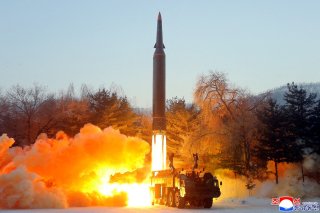North Korea Carries Out Second Missile Test in Six Days
North Korea is one of five countries currently developing hypersonic missile technology.
North Korea fired a suspected ballistic missile into the Sea of Japan on Tuesday, marking Pyongyang’s second test launch in six days.
South Korea’s Joint Chiefs of Staff said the DPRK fired what was likely a ballistic missile from the country’s northern Jagang province. The alleged projectile flew around 700 kilometers at a maximum speed of around Mach 10—well above the Mach 5 threshold necessary to be considered hypersonic—and reached a height of sixty kilometers. The launch follows closely on the heels of a similar test conducted last week, which involved an allegedly hypersonic missile that was also fired from Jagang.
The missile in question is believed to be more advanced than the one North Korea tested last week. Nevertheless, Seoul signaled confidence in the ability of South Korea’s military to counter weapons of this type. "Our military has the ability to detect and intercept this projectile, and we are continuously strengthening our response system,” read a South Korean government statement, adding that Seoul "expressed a strong regret over the North's launch, which took place at a time when political stability is very important." A statement from U.S. Indo-Pacific Command echoed Seoul’s concerns, noting that "the missile launch highlights the destabilizing impact of the DPRK’s illicit weapons program."
The DPRK has not commented publicly on Tuesday’s launch as of the time of writing. North Korean state media offered details within one day of Pyongyang’s test last week. According to Fox News, the Federal Aviation Authority (FAA) reportedly ordered a full ground stop at airports in the western United States on Monday at around the same time as North Korea’s alleged missile launch.
"Today's test might be intended to send a message to the South after authorities here said the earlier test was a failure and did not involve a hypersonic missile," Kim Dong-yup, a former South Korean Navy officer who now teaches at Seoul's Kyungnam University, told Reuters. Tuesday’s suspected launch comes amid an eleventh-hour effort by South Korean President Moon Jae-in, who is set to leave office this spring, to secure a lasting peace deal with Pyongyang.
North Korean leader Kim Jong-un urged his country’s defense sector late last year to develop an “invincible military capability” that no one will dare challenge. This capability involves an ongoing effort to acquire hypersonic glide vehicles (HGVs), which can travel at greater speeds and are much more maneuverable than their traditional ballistic missile counterparts. The DPRK has become one of five countries—with the others being India, China, Russia, and the United States—to be actively engaged in developing and producing hypersonic missile technology.
Mark Episkopos is a national security reporter for the National Interest.
Image: Reuters.

